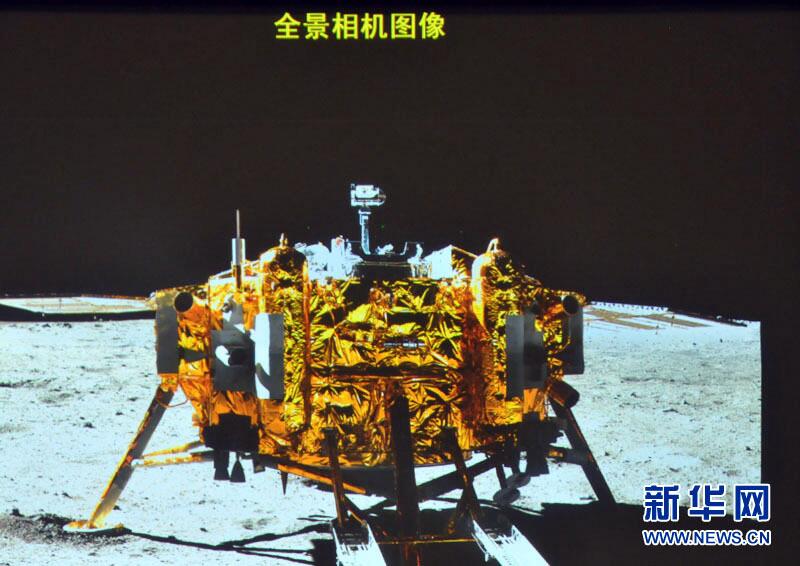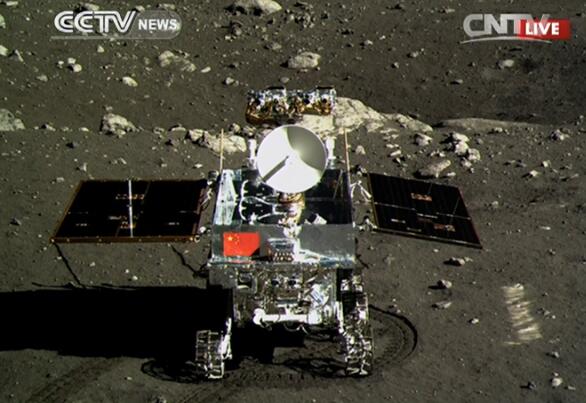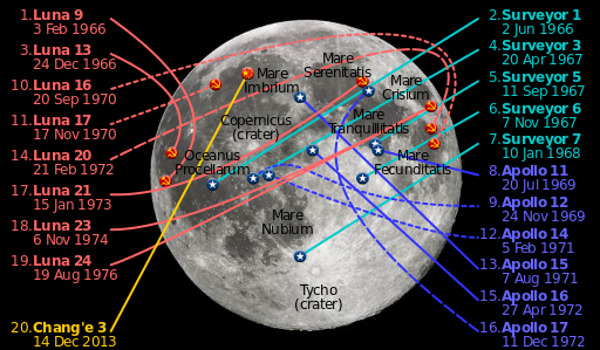It looks like you're using an Ad Blocker.
Please white-list or disable AboveTopSecret.com in your ad-blocking tool.
Thank you.
Some features of ATS will be disabled while you continue to use an ad-blocker.
share:
eNaR
reply to post by mirageman
Spoiler: All Your Base Are Belong to Us [Not US]
I know as I had already pointed out previously ...

scotsdavy1
reply to post by Wolfenz
Saw on the news today about their rover starting to explore.
Chinese scientist said they had to make new optics for the cameras due to the temperature variations on the moon.
It has infra red plus many more different ones fitted to it.
Will be interesting to see what they discover there.
still as it Look NO HD Quality ? hmm wonder why the Temperature may be a problem but i can say Ive seen Apollo missions on the Moon from those Classified cameras from stills to film ! that are Crystal Clear like Hi Def .. no Grainy Potato Camera from these Classified Cameras tho The Government Shows the Dilute Version of the Stills and DIFFERENT VIDEOS ( Film ) From what ive have seen ... IT IS CLAIMED The Films Came from a Japanese Site !! and NASA usually give the carbon copy's Duplicate to Japan for safe Keeping from what ive been told.. and was told about the lost films of apollo missions that japan has them .. I tend to believe that NASA duplicate everything.. and send their copy's to puppet country's like Japan ..
What is the temperature on the Moon? The temperature on the Moon varies from -387 Fahrenheit (-233 Celsius), at night, to 253 Fahrenheit (123 Celsius) during the day. Because the Moon has no atmosphere to block some of the Sun's rays or to help trap heat at night, its temperature varies greatly between day and night.
The big debate for me is this:
Chinese pictures of the moon show a different colour to the Apollo.
Of course there are different types of cameras and settings they are using.
But why would "Scientists" want to take pictures knowing they wouldn't be showing true colours?
Also, if they claim to be true colour, who is lying?
NASA or China? or Both?
Chinese pictures of the moon show a different colour to the Apollo.
Of course there are different types of cameras and settings they are using.
But why would "Scientists" want to take pictures knowing they wouldn't be showing true colours?
Also, if they claim to be true colour, who is lying?
NASA or China? or Both?
reply to post by brace22
Most probably it is not the scientists using the camera at the moment, but the engineers who want to have the most contrast in what they see, so that they can control the rover.
Most probably it is not the scientists using the camera at the moment, but the engineers who want to have the most contrast in what they see, so that they can control the rover.
crazyewok
ipsedixit
Congratulations to China.
Wouldn't it be nice if this just became all about science and not just an expansion of unhealthy competition into another arena? If only . . .
Its that hippy crap thats holding us back.
We need to expand and exploit the solar system.
If one day we are going to have colonies on the moon and mars and help solve our resource and popukation problems we need competition and a strong drive.
I don't think that's the intention of landing a rover on the moon but rather - control.
That is, "he who controls the moon controls the earth" - sadly.
Whoever can establish a moon base can pretty much control all communications.
This is just the first step...
brace22
But why would "Scientists" want to take pictures knowing they wouldn't be showing true colours?
For geological reasons.
They're scientists remember.
Because different types of rocks reflect differently at differnt wavelengths, false color images give geologists back on earth some information that would not be available if all photos were taken in "true color".
A google search given a bazillion pages on the topic, but here's one random link to do with Mars.
Its full of phrases like:
The rocks are less red and have less of a bend in the spectrum at visible wavelengths, indicating less ferric minerals and a more unweathered composition than drift. The intermediate colored soils appear intermediate in the spectral properties as well. The dark red soil at Lamb is darker than drift by about equally as red; the curvature of sppectrum at visible wavelengths indicates either more ferric minerals or a larger particle size.
and
The strength of the bend, or "kink", in the spectrum is related to the abundance and particle size of specific crustalline, ferric weathering products. In the false color image, the blue areas have a weak kink and are relatively unweathered, whereas the red areas' strong kink indicates an abundance of ferric iron minerals.
Conspiracy theorists dont like it though.
reply to post by guohua
Um...doesn't everyone in the world do that???
and China does Everything For A reason
Um...doesn't everyone in the world do that???
reply to post by scotsdavy1
I await the the outcome with fingers crossed But going on the past actions of china concerning public openness i doubt we will get more than the gray typical reports from a goverment who do things such as the chinese internet restrictions with there the Great Firewall and golden sheild etc For poeple to think they will be forthcoming with more info than the other nations who have wore these shoes before..so to speak is hard for me to swallow
Indisputable
I await the the outcome with fingers crossed But going on the past actions of china concerning public openness i doubt we will get more than the gray typical reports from a goverment who do things such as the chinese internet restrictions with there the Great Firewall and golden sheild etc For poeple to think they will be forthcoming with more info than the other nations who have wore these shoes before..so to speak is hard for me to swallow
Indisputable
*meanwhile on the Moon*
Chang'e-3 lander (image taken by the Yutu rover)

Vice versa

And a nice hq video of Chang'e-3 landing
Chang'e-3 lander (image taken by the Yutu rover)

Vice versa

And a nice hq video of Chang'e-3 landing
scotsdavy1
alfa1
scotsdavy1
will see if they pick up the stars from the moon as well....
Why would you expect the cameras to pick up stars if the exposure is set for viewing the surface?
Is it because being "in space" somehow magically changes the laws of optics?
Was just a thought, you don't need to be so sarcastic
I've noticed a rising in this on ATS with a lot of members.. it's like they pick out a statement and to try to go out of their way to sound smarter than someone who is just expressing their thoughts on a topic.. it's actually quite rude and pathetic since this IS a discussion.
On topic, It will be very interesting to compare photo's from the U.S. and see if there are any inconsistancies..
reply to post by zilebeliveunknown
Thanks for those images.
So far, the Moon in images taken by the Jade Rabbit looks similar to the Moon in images taken by the Apollo astronauts (which is not surprising).
Thanks for those images.
So far, the Moon in images taken by the Jade Rabbit looks similar to the Moon in images taken by the Apollo astronauts (which is not surprising).
edit on 12/15/2013 by Box of Rain because: (no reason given)
Pfft. Land on the "dark side" of the moon, already! And show us all the alien bases!
reply to post by scotsdavy1
Now for something really conspiracy worthy ... I don't have the time to check for references but I'm pretty sure they landed in the same bay that the USSR choosed to land their rovers in the 70's. Why? The moon isn't that small ...
Now for something really conspiracy worthy ... I don't have the time to check for references but I'm pretty sure they landed in the same bay that the USSR choosed to land their rovers in the 70's. Why? The moon isn't that small ...
reply to post by 2timesOO
Interesting theory, maybe a member here can provide the answer plus link to it?
Interesting theory, maybe a member here can provide the answer plus link to it?
reply to post by scotsdavy1
Lunokhod 1 landed in the "sea of rains" where the rainbow bay is (and I'm pretty sure it landed in the rainbow bay).
Lunokhod 1 landed in the "sea of rains" where the rainbow bay is (and I'm pretty sure it landed in the rainbow bay).
2timesOO
reply to post by scotsdavy1
Now for something really conspiracy worthy ... I don't have the time to check for references but I'm pretty sure they landed in the same bay that the USSR choosed to land their rovers in the 70's. Why? The moon isn't that small ...
The various landing locations for Moon exploration over the years has been in various places.
The landing location of Chang'e 3 and the "Jade Rabbit" rover is in the general location (in Mare Imbrium) of the first Russian Moon rover (Luna 17/Lunakhod 1), but is NOT near the second Russian Moon rover (Luna 21/Lunakhod 2), which landed in Mare Serenitatis:

Image Source
edit on 12/15/2013 by Soylent Green Is People because: (no reason given)
I read somewhere that they want to weaponize it. Probably searching to see if the best area is a good spot to plant it..
reply to post by boymonkey74
This page has the most info I have found on the instruments, including the cameras. Seems like those images are just from a fairly normal camera, but details are not given. They are automatic exposure settings.
The Astronomy telescope is in near UV and UV (no visible light capability)
And an imaging spectrograph.
Chang'e 3 - Mission Overview
www.spaceflight101.com...
My first impression is that it seems quite dark up there, even though they should be in full, though low angle, sunlight. That image showing the brown/red surface also displays brightness fall-off away from the central, better lit area, so I think they were using supplemental lighting.
This page has the most info I have found on the instruments, including the cameras. Seems like those images are just from a fairly normal camera, but details are not given. They are automatic exposure settings.
The Astronomy telescope is in near UV and UV (no visible light capability)
And an imaging spectrograph.
Chang'e 3 - Mission Overview
www.spaceflight101.com...
My first impression is that it seems quite dark up there, even though they should be in full, though low angle, sunlight. That image showing the brown/red surface also displays brightness fall-off away from the central, better lit area, so I think they were using supplemental lighting.
edit on 15-12-2013 by GaryN because: sp.
scotsdavy1
reply to post by alfa1
"What does the old Moon look like from 60 miles?" "Essentially gray; no color" -Jim Lovell, Apollo 8 ( history.nasa.gov... )
"Like plaster of paris or a sort of grayish beach sand."
i29.tinypic.com...
( upload.wikimedia.org... (upload.wikimedia.org...) )
Pertaining to the color of the moon as viewed from the surface, Jim Irwin wrote an article August 30, 1971:
"When I first climbed down the ladder of Apollo 15's lunar module," he talked about the mountains and horizon. And then Irwin talked about colors, "But the real surprise was that the mountains, at first sight, were not grey or brown as I had expected. They were golden. Looking to the south and east, I saw the reflection of the early morning sun glancing off the mountains, especially Hadley Delta, give them a glow of gold."
Does the moon have gold in them thar hills? Will the Chinese continue posting earthy-toned, brown-toned images in the face of what NASA has insisted is a gray-scale moon?
edit on 12/15/2013 by SayonaraJupiter because: edit tags
new topics
-
Meta Llama local AI system is scary good
Science & Technology: 1 hours ago -
This is why ALL illegals who live in the US must go
Social Issues and Civil Unrest: 3 hours ago -
UK Borders are NOT Secure!
Social Issues and Civil Unrest: 4 hours ago -
Former ‘GMA Producer’ Sues NPR-Legacy Media Exposed
Propaganda Mill: 6 hours ago -
New Footage - Randy Rhoads 1979 LIVE Guitar Solo Footage at the Whisky - Pro Shot
Music: 7 hours ago -
Happy Hanukkah…
General Chit Chat: 7 hours ago
top topics
-
This is why ALL illegals who live in the US must go
Social Issues and Civil Unrest: 3 hours ago, 9 flags -
Former ‘GMA Producer’ Sues NPR-Legacy Media Exposed
Propaganda Mill: 6 hours ago, 8 flags -
A Merry Christmas.
General Chit Chat: 14 hours ago, 7 flags -
Happy Hanukkah…
General Chit Chat: 7 hours ago, 7 flags -
UK Borders are NOT Secure!
Social Issues and Civil Unrest: 4 hours ago, 6 flags -
New Footage - Randy Rhoads 1979 LIVE Guitar Solo Footage at the Whisky - Pro Shot
Music: 7 hours ago, 5 flags -
Meta Llama local AI system is scary good
Science & Technology: 1 hours ago, 3 flags
active topics
-
Meta Llama local AI system is scary good
Science & Technology • 9 • : glend -
Happy Hanukkah…
General Chit Chat • 19 • : Naftalin -
This is why ALL illegals who live in the US must go
Social Issues and Civil Unrest • 8 • : Echo007 -
NYPD arrests migrant who allegedly set woman on fire on subway train, watched her burn to death
Breaking Alternative News • 55 • : xuenchen -
Plane Crash Today --Azerbaijanian E190 passenger jet
Mainstream News • 36 • : Oldcarpy2 -
FAA Investigates Christmas Drone Show Gone Wrong in Orlando, FL 12/2024
Other Current Events • 11 • : ScottKirkland -
It's Offical Now
US Political Madness • 26 • : Oldcarpy2 -
This is an interesting picture. Do we actually pick our leaders?
Politicians & People • 13 • : GENERAL EYES -
Panamanian President-“every square meter” of the Panama Canal belongs to Panama.
New World Order • 45 • : SCUBAPAUL -
-@TH3WH17ERABB17- -Q- ---TIME TO SHOW THE WORLD--- -Part- --44--
Dissecting Disinformation • 3820 • : Thoughtful3
